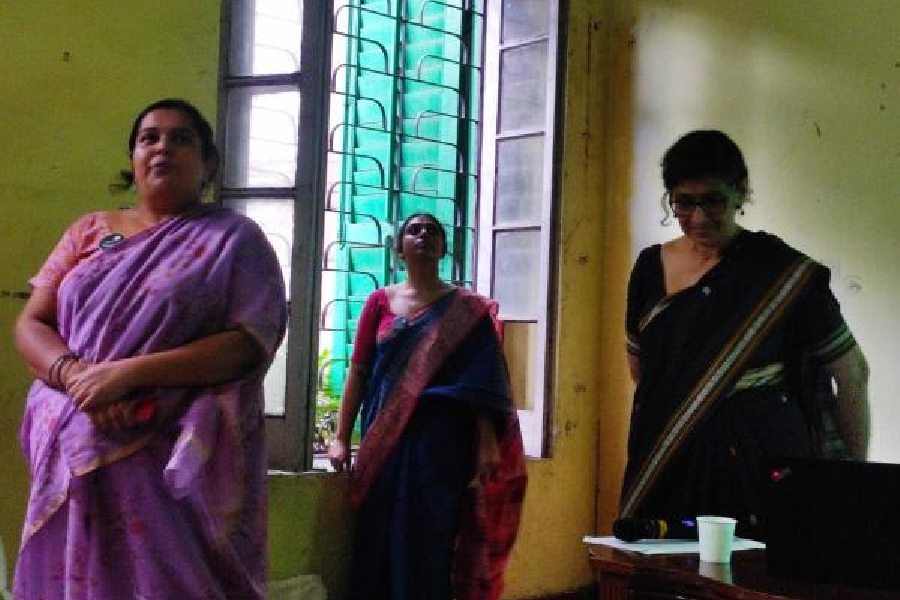The city museum division of DAG, formerly Delhi Art Gallery, has returned with its third edition of The City as a Museum, an art and cultural festival organised at various sites in the city.
In this ongoing chapter, visitors and participants have so far been told stories of the origins of art and craft institution-building, of how the domestic space was influenced by Swadeshi ideas that changed the way the baithakkhana looked and how satirical illustrations and cartoons influenced and continue to influence readership.
As with previous editions, this year’s edition, too, is a mix of walks, talks, workshops, at various places that are organic to the art and culture of the city.
The festival kicked off on November 17 evening with art historian Tapati Guha Thakurta’s talk-and-walk session through the premises of the Government College of Art and Craft and the adjacent Indian Museum, tracing the origin story of ‘industrial’ and ‘decorative art’.
Guha Thakurta focussed on the intertwined history of the two most important institutions of the city located next to each other. The two were connected both physically and ideologically at the time of their foundation to the practice, preservation and collection of art and craft.
“Indian craft traditions have a history that goes much further back than the Empire. However, the Victorian Empire was the time when interest was generated in industrial and decorative art as opposed to the high arts of painting, sculpture and architecture. The appreciation of such art objects lay in the imagination and design that went into it. The focus was on labour and manufacturing skills and expertise in dealing with materials like wood, iron, stone, ivory and there were groups who had hereditary skills that were remobilised by the imperial government and their institutions,” she said.
The Government College of Art and Craft, called the Calcutta School of Art at the time was set up in 1854, was one in the network of art colleges set up during the colonial empire. It was initially established in north Kolkata’s Garanhata, and later moved to the present premises in the 1890s.
The Indian Museum, founded in 1814 at the Asiatic Society by Nathaniel Wallich, shifted to its present building in Chowringhee in 1878 that was built by W.H. Granville.
On the second day of The City as a Museum, Rosinka Chaudhuri, director of Jadunath Bhavan Museum & Resource Centre, spoke on the genealogy of furniture showing Swadeshi influence on our homes and living spaces.
Visitors were taken to an antique furniture warehouse and the house of Jadunath Sarkar to give a sense of how furniture in our domestic spaces evolved from the colonial to the Swadeshi times.
Starting from 1650 onwards, she presented chairs from the Coromandel coast with carved ebony spiral legs to caned chairs that were popular in England because they were cheaper, lighter and less prone to dust and pest than their upholstered equivalent.
With a walk around a warehouse and later, historian Jadunath Sarkar’s home, she demonstrated the evolution of the Indian drawing room from the Buckingham Palace style decor to a middle-class Swadeshi style that was pioneered by the Tagores as is evident from the Jorasanko furniture.
Interesting nuggets emerged like the origins of teapoy.
“The word teapoy came from the Hindi ‘tin’ and ‘pai’ meaning three legs. Tripod tables and small pillar tables in general were known as teapoys. Furniture makers copied the teapoy form directly from the European candlestand. People used teapoys mainly as stands for candles, although illustrations show that they were sometimes also used as hookah stands. In Britain, the term teapoy was mistakenly linked with tea. The British began to use it to describe a small pillar table incorporating a caddy or chest fitted with the storage and consumption of tea,” said Sumana Chakraborty of DAG.
An exhibition and workshop on Bengal’s caricature art on socio-political issues through humour and satire titled Byango-Darshan was held at Haritaki Bagan Bari in Maniktala on Sunday.
Cartoon Dol, a group of contemporary artists practising and disseminating news and views on cartoons as practised since 19th century Bengal, put up an exhibition of its collections.
On view were Chittoprasad’s satire-dripping drawings of 1947 vintage from DAG’s collection, Somenath Hore’s drawings and Abanindranath’s visual representation of pressing social issues. From Cartoon Dol’s archives, visitors were treated to Rebati Bhushan’s caricatures and strips by Prafulla Chandra Lahiri.
